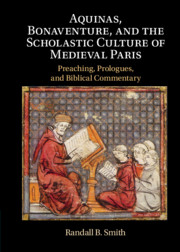 Aquinas, Bonaventure, and the Scholastic Culture of Medieval Paris
Aquinas, Bonaventure, and the Scholastic Culture of Medieval Paris Book contents
- Aquinas, Bonaventure, and the Scholastic Culture of Medieval Paris
- Aquinas, Bonaventure, and the Scholastic Culture of Medieval Paris
- Copyright page
- Dedication
- Contents
- Acknowledgments
- Introduction
- Part One Preliminaries
- 1 Preaching and Principia at the University of Paris
- 2 The Basic Elements of the Thirteenth-Century “Modern Sermon”
- 3 Principia and the Sermo Modernus
- Part Two Thomas Aquinas
- Part Three Bonaventure
- Appendix 1 Outlines of the Divisiones Textus of the Books of the Bible from the Inception Resumptio Addresses of Four Thirteenth-Century Masters
- Works Cited
- Index
2 - The Basic Elements of the Thirteenth-Century “Modern Sermon”
from Part One - Preliminaries
Published online by Cambridge University Press: 05 February 2021
- Aquinas, Bonaventure, and the Scholastic Culture of Medieval Paris
- Aquinas, Bonaventure, and the Scholastic Culture of Medieval Paris
- Copyright page
- Dedication
- Contents
- Acknowledgments
- Introduction
- Part One Preliminaries
- 1 Preaching and Principia at the University of Paris
- 2 The Basic Elements of the Thirteenth-Century “Modern Sermon”
- 3 Principia and the Sermo Modernus
- Part Two Thomas Aquinas
- Part Three Bonaventure
- Appendix 1 Outlines of the Divisiones Textus of the Books of the Bible from the Inception Resumptio Addresses of Four Thirteenth-Century Masters
- Works Cited
- Index
Summary
To understand the sermo modernus style of preaching, it is necessary to understand how it differed from what preceded it. In the early fourteenth century, Thomas Waleys, an Oxford Dominican, looking back on the “homiletic revolution” of the thirteenth century, wrote a widely circulated tract entitled “On the manner of composing sermons” (De modo componendi sermones). The difference between the “modern” sermons of the thirteenth century and the “ancient” sermons of the Church Fathers, said Waleys, was that, whereas the “ancient” sermon consisted of a verse-by-verse commentary on the entire Gospel reading for the day, the “modern” sermon was built around a thema or single Bible verse. Indeed, as Michèle Mulcahey notes, “The theme [that is, the thema] of a sermon modernus was often likened by the authors of preaching manuals to the root of a tree which was the sermon, or similarly it was the trunk from which sprung the various branches.”
- Type
- Chapter
- Information
- Aquinas, Bonaventure, and the Scholastic Culture of Medieval ParisPreaching, Prologues, and Biblical Commentary, pp. 45 - 66Publisher: Cambridge University PressPrint publication year: 2021
